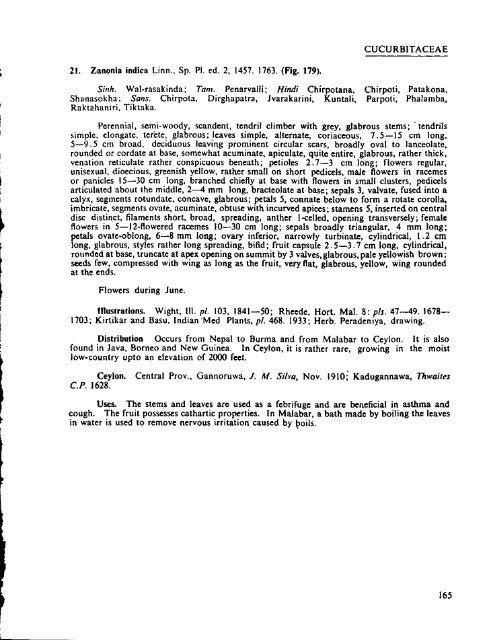,r\/*> - National Science Foundation
,r\/*> - National Science Foundation
,r\/*> - National Science Foundation
Create successful ePaper yourself
Turn your PDF publications into a flip-book with our unique Google optimized e-Paper software.
21. Zanonia indica Linn.. Sp. PI. ed. 2. 1457. 1763. (Fig. 179).<br />
CUCURBITACEAE<br />
Sinh. Wal-rasakinda; Tam. Penarvalli; Hindi Chirpotana. Chirpoti, Patakona,<br />
Shanasokha; Sans. Chtrpota, Dirghapatra, Jvarakarini, Kuntali, Parpoti, Phalamba,<br />
Raktahantri. Tiktaka.<br />
Perennial, semi-woody, scandent, tendril climber with grey, glabrous stems; tendrils<br />
simple, elongate, terete, glabrous; leaves simple, alternate, coriaceous, 7.5—15 cm long,<br />
5—9.5 cm broad, deciduous leaving prominent circular scars, broadly oval to lanceolate,<br />
rounded or cordate at base, somewhat acuminate, apiculate, quite entire, glabrous, rather thick,<br />
venation reticulate rather conspicuous beneath; petioles 2.7—3 cm long; flowers regular,<br />
unisexual, dioecious, greenish yellow, rather small on short pedicels, male flowers in racemes<br />
or panicles 15—30 cm long, branched chiefly at base with flowers in small clusters, pedicels<br />
articulated about the middle, 2—4 mm long, bracteolate at base; sepals 3, valvate, fused into a<br />
calyx, segments rotundate, concave, glabrous; petals 5, connate below to form a rotate corolla,<br />
imbricate, segments ovate, acuminate, obtuse with incurved apices; stamens 5, inserted on central<br />
disc distinct, filaments short, broad, spreading, anther l-cclled, opening transversely; female<br />
flowers in 5—12-flowered racemes 10—30 cm long; sepals broadly triangular, 4 mm long;<br />
petals ovate-oblong, 6—8 mm long; ovary inferior, narrowly turbinate, cylindrical, 1.2 cm<br />
long, glabrous, styles rather long spreading, bifid; fruit capsule 2.5—3.7 cm long, cylindrical,<br />
rounded at base, truncate at apex opening on summit by 3 valves, glabrous, pale yellowish brown;<br />
seeds few, compressed with wing as long as the fruit, very flat, glabrous, yellow, wing rounded<br />
at the ends.<br />
Flowers during June.<br />
Illustrations. Wight. III. pi. 103, 1841—50; Rheede, Hort. Mai. 8: pis. 47—49. 1678—<br />
1703; Kirtikar and Basu. Indian Med Plants, pi. 468. 1933; Herb. Peradeniya, drawing.<br />
Distribution Occurs from Nepal to Burma and from Malabar to Ceylon. It is also<br />
found in Java, Borneo and New Guinea. In Ceylon, it is rather rare, growing in the moist<br />
low-country upto an elevation of 2000 feet.<br />
Ceylon. Central Prov., Gannoruwa, /. M. Siha, Nov. 1910; Kadugannawa, Thwaites<br />
CP. 1628.<br />
Uses. The stems and leaves are used as a febrifuge and are beneficial in asthma and<br />
cough. The fruit possesses cathartic properties. In Malabar, a bath made by boiling the leaves<br />
in water is used to remove nervous irritation caused by (poils.<br />
165
















